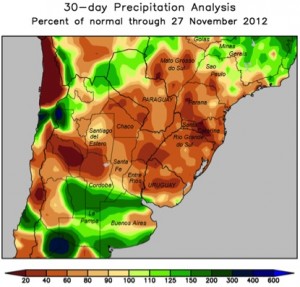Last night the USDA issued the latest crop condition report which, unsurprisingly, saw a further reduction in US winter wheat rated as good/excellent from 36% to 34%. The poor/very poor proportion increased from 22% to 24%. The good/excellent figure is a record low and attributable to the persistent drought conditions experienced in the Plains. It would appear that the US soil moisture profile is the seventh lowest since the turn of the LAST century and the Plains are the driest EVER recorded. These conditions are elevating concern levels not only for grain production, but also for consumers and graziers alike.
We hear that it is the percentage of the crop recorded in the poor/very poor category that provides a better correlation to yield rather than the correlation with good/excellent, and, given the dry outlook over the next couple of weeks, we are already picking up on discussions of reduced US wheat output. Clearly, how the crop overwinters and the amount of moisture which the soils can accumulate over the winter will be crucial to 2013 output.
Closer to home, we have looked at EU grain end stocks previously, and reported on the extreme tightness of supply, currently estimated at some three weeks usage. The ongoing pace of grain exports shows little, if any, sign of letting up, and with cumulative grain shipments hitting 9.6 million mt (wheat and barley combined) we are more than 10% ahead of the same time last year and well ahead of USDA forecasts. We either need to reduce the pace of exports or increase imports of grains to restore the balance sheet to manageable levels.
The likely grain of choice for importation will be corn, and reports circulating at present estimate that some 12 million mt will be required to balance the books. “Where from?” is the question. Brazil is not offering into next year as supplies appear to be well committed and the tight US position would seem unlikely to provide the necessary volume.
The requisite action is for EU grain prices to rise, and do so soon, to limit further exports by becoming uncompetitive in the global market place; thereby driving the US into the supply role (at last). When the world wakes up to this pattern we expect to see explosive price action (to the upside) unfold.




